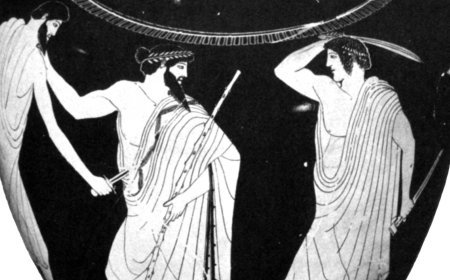The Straw Man
The Straw Man fallacy is incredibly prevalent in political discourse, debates on social issues, and even everyday arguments. It thrives on simplification and misdirection, making it a powerful tool for those more interested in winning an argument than in truly understanding or refuting an opponent's point.

The Straw Man fallacy is a deceptive rhetorical tactic where an arguer distorts, misrepresents, or exaggerates an opponent's argument to make it easier to attack. Instead of engaging with the actual, nuanced position, they construct a "straw man"—a flimsy, easily knocked-down caricature of the real argument—and then proceed to demolish this fabricated version. The illusion created is that the original argument has been defeated, when in fact, it was never truly addressed.
The Mechanism of the Straw Man
The core of the Straw Man fallacy lies in the misrepresentation. Instead of accurately quoting or summarizing an opponent's position, the attacker subtly (or overtly) twists it into something else. This distorted argument is then attacked, and once the attacker "defeats" this fabricated version, they falsely conclude that the original, unaddressed argument has been refuted.
The wordings that often characterize a Straw Man fallacy are crucial to its operation. You'll frequently hear phrases like:
- "So what you're really saying is..." (followed by a distorted interpretation)
- "You're trying to suggest that..." (attributing an unstated, extreme claim)
- "If we followed your logic, we'd end up with..." (exaggerating consequences)
- "My opponent believes we should just [extreme, simplified action]..."
- "They want to [undesirable, overblown outcome]..."
These wordings create a convenient target, allowing the arguer to avoid the complexity and strength of the actual position.
How a Straw Man is Constructed (and Its Variations)
A Straw Man can be built in several ways:
-
Oversimplification: Reducing a complex, nuanced argument to a basic, easily refutable point.
- Original Argument: "I believe we should invest more in public transportation to reduce traffic congestion and carbon emissions."
- Straw Man Misrepresentation: "So, you want to force everyone out of their cars and make them ride crowded buses? That's infringing on personal freedom!"
- The wordings here strip away the multiple benefits and flexible options, focusing solely on a perceived negative impact.
-
Exaggeration: Taking a legitimate argument and inflating it to an extreme, absurd, or catastrophic level.
- Original Argument: "Schools should consider healthier lunch options and teach children about nutrition."
- Straw Man Misrepresentation: "My opponent wants to control every bite your child eats and turn school lunches into a joyless, tasteless experience imposed by the government!"
- The wordings here amplify a reasonable suggestion into an overreaching, draconian measure, often using hyperbole like "control every bite" or "joyless."
-
Fabrication/Inventing an Argument: Attributing an argument to an opponent that they never actually made. This is a complete invention.
- Original Argument: (No argument was made on this topic, or it was completely different).
- Straw Man Misrepresentation: "My opponent has publicly stated that they believe all private businesses should be nationalized. Clearly, that would destroy our economy!"
- This is a bald-faced lie, with wordings directly asserting a false claim about the opponent's position.
-
Selective Quoting (Out of Context): Picking a small part of an opponent's statement and presenting it as their entire argument, often removing crucial context that clarifies the original meaning.
- Original Statement (long, nuanced): "While I agree that some regulation is necessary to prevent corporate abuse, we must also ensure that regulations don't stifle innovation or create undue burdens on small businesses. A balanced approach is key, perhaps with a focus on outcome-based rather than prescriptive rules."
- Straw Man Misrepresentation: "My opponent clearly said, 'some regulation is necessary,' showing their true colors as a big government interventionist who wants to strangle businesses with red tape!"
- The wordings highlight the selected phrase while ignoring the vital qualifiers and calls for balance.
-
Focusing on a Minor Point as the Main Point: Taking a tangential or secondary point from an opponent's argument and treating it as their central thesis, then attacking it.
- Original Argument: (Primarily about reducing crime through community policing and job creation, with a small mention of potentially reviewing minor drug laws.)
- Straw Man Misrepresentation: "My opponent's entire crime fighting strategy boils down to legalizing drugs! That's a recipe for disaster!"
- The wordings inflate a minor detail into the whole argument, misrepresenting the focus.
Why the Straw Man is So Effective (and Harmful)
The effectiveness of the Straw Man fallacy stems from several psychological and rhetorical advantages:
- Ease of Attack: It's much easier to attack a simplified, exaggerated, or fabricated argument than a complex, well-reasoned one. This saves the attacker the effort of genuine critical engagement.
- Creates a Clear Enemy: By misrepresenting the opponent as holding an extreme or absurd view, the Straw Man creates a clearer, more demonizable "enemy" for the audience.
- Appears to be a Refutation: When the Straw Man is successfully "defeated," it gives the audience the false impression that the original, more robust argument has also been refuted. This can be very convincing, especially to an audience not fully familiar with the original position.
- Distraction: It diverts attention away from the real issues and towards a fabricated controversy.
- Moral High Ground: The attacker can sometimes appear to be the more reasonable or morally sound individual by easily refuting the "extreme" position they've invented for their opponent.
The harm caused by the Straw Man fallacy is significant. It prevents productive dialogue, fosters misunderstanding, and can poison the well of public discourse. Instead of encouraging genuine debate and problem-solving, it promotes misrepresentation and antagonism. It can lead to policy decisions based on distorted views rather than accurate understanding of proposed solutions. When political opponents consistently use Straw Man arguments, it makes it nearly impossible for meaningful compromise or consensus to be reached, as each side is battling a caricature of the other.
Identifying and Countering the Straw Man
Spotting a Straw Man requires careful listening or reading. Pay attention to the wordings used by the arguer to describe their opponent's position. Does it sound like an accurate, charitable representation, or does it seem overly simplistic, extreme, or even completely made up? If an argument sounds too ridiculous or extreme to be genuinely held by a reasonable person, it's a good sign that a Straw Man might be in play.
To effectively counter a Straw Man fallacy:
- Clearly State Your Original Position: Reiterate your actual argument in a clear, concise, and unambiguous way.
- Example Counter: "That's not what I said. My argument was X..."
- Point Out the Misrepresentation: Explicitly identify the distortion and explain how it differs from your actual stance.
- Example Counter: "You're exaggerating my position. I never advocated for that; what I proposed was Y."
- Using "wordings" to highlight the contrast: "Your wordings make it sound like I want to abolish cars, but my actual wordings focused on expanding choices, not eliminating them."
- Correct the Record: Don't just deny; actively correct. Provide the correct information or the nuance that was omitted.
- Example Counter: "To be clear, my proposal involves [detailed explanation], not the drastic measure you've described."
- Demand Engagement with the Real Argument: Redirect the conversation back to the actual substance of your original argument.
- Example Counter: "Now that I've clarified my position, would you like to discuss the merits of my actual proposal, rather than the distorted version?"
- Call Out the Fallacy (Optional): If appropriate, you can name the fallacy directly, which can be an educational moment for the audience.
- Example Counter: "That's a classic straw man argument. You've created a false version of my stance just to make it easier to attack."
- Avoid Getting Drawn into the Straw Man Debate: Don't spend too much time refuting the distorted argument. Briefly correct it and pivot back to your actual point. Engaging with the Straw Man on its own terms validates it.
In conclusion, the Straw Man fallacy, characterized by its manipulative wordings and deliberate misrepresentations, is a significant obstacle to rational discourse. Recognizing when an opponent is attacking a fabricated version of an argument rather than the real one is a vital skill. By understanding its mechanics and employing effective countering strategies, individuals can defend their positions, expose rhetorical trickery, and promote more honest and productive exchanges of ideas.
Want to know more about fallacies? Click here to read about Argumentum ad Populum fallacy
What's Your Reaction?
 Like
0
Like
0
 Dislike
0
Dislike
0
 Love
0
Love
0
 Funny
0
Funny
0
 Angry
0
Angry
0
 Sad
0
Sad
0
 Wow
0
Wow
0





















